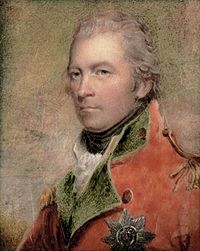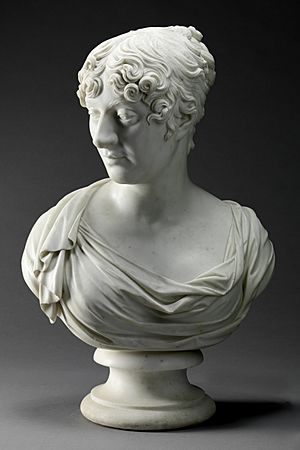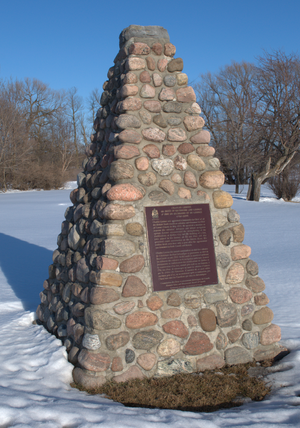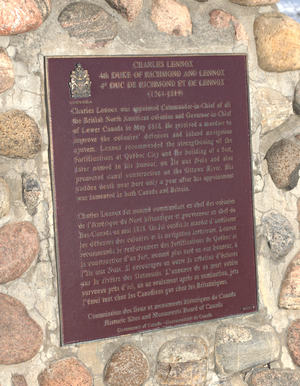Charles Lennox, 4th Duke of Richmond facts for kids
Quick facts for kids
His Grace General
The Duke of Richmond and Lennox
|
|
|---|---|
 |
|
| Lord Lieutenant of Ireland | |
| In office 11 April 1807 – 23 June 1813 |
|
| Monarch | George III |
| Prime Minister | The Duke of Portland Hon. Spencer Perceval The Earl of Liverpool |
| Preceded by | The Duke of Bedford |
| Succeeded by | The Viscount Whitworth |
| Governor General of British North America | |
| In office 1818–1819 |
|
| Monarch | George III |
| Preceded by | Sir John Coape Sherbrooke |
| Succeeded by | The Earl of Dalhousie |
| Member of Parliament for Sussex |
|
| In office 1790–1806 |
|
| Preceded by | Lord George Lennox |
| Succeeded by | Charles William Wyndham |
| Personal details | |
| Born | 9 December 1764 Gordon Castle, Scotland |
| Died | 28 August 1819 (aged 54) Richmond, British North America |
| Nationality | British |
| Political party | Tory |
| Spouse | Lady Charlotte Gordon |
| Children | 14, including Charles, John, William, Sussex, and Arthur |
| Parents | Lord George Lennox Lady Louisa Kerr |
| Military service | |
| Allegiance | United Kingdom |
| Branch/service | British Army |
| Years of service | 1785–1819 |
| Rank | General |
| Unit | Coldstream Guards |
| Commands | 35th Regiment of Foot |
| Battles/wars | |
General Charles Lennox, 4th Duke of Richmond and Lennox (born December 9, 1764 – died August 28, 1819), was an important British figure. He was a soldier, a politician, and even served as the Governor-General of British North America (which included parts of modern-day Canada). He was also known for his love of cricket.
Contents
Early Life and Family
Charles Lennox was born into a noble family in Scotland. His father was General Lord George Lennox. His grandfather was Charles Lennox, the 2nd Duke of Richmond. Charles had several famous aunts, known as the Lennox sisters.
A Passion for Cricket
Richmond loved playing cricket. He was a skilled player, good at batting and a noted wicket-keeper. He played as an amateur, meaning he didn't get paid for playing.
Founding Lord's Cricket Ground
He was a founding member of the Marylebone Cricket Club (MCC). In 1786, he helped Thomas Lord start a new cricket ground. This led to the creation of Lord's Cricket Ground. Lord's is now one of the most famous cricket grounds in the world. It is often called the "Home of Cricket."
Military Career
Richmond became a British Army captain in 1787. He rose through the ranks to become a colonel. He was known for being very protective of his honor.
Challenges and Conflicts
In 1789, he had a disagreement with Frederick, Duke of York. This led to a duel where Richmond fired a shot. Luckily, no one was seriously hurt. He later had another duel with a writer named Theophilus Swift. Swift was injured but recovered.
Richmond served in naval battles against the French in the West Indies and Gibraltar. However, he sometimes disagreed with his commanders. He was also a Member of Parliament for Sussex from 1790 to 1806.
Marriage and Family
Later in 1789, he married Lady Charlotte Gordon. They had a large family with fourteen children.
Becoming a Duke
In 1806, Charles Lennox became the 4th Duke of Richmond. This happened after his uncle passed away.
Lord Lieutenant of Ireland
In 1807, he was appointed Lord Lieutenant of Ireland. This was a very important role, representing the British monarch in Ireland. He held this position until 1813.
The Duchess of Richmond's Ball
During the Napoleonic Wars, in 1815, the Duke was in Brussels. He commanded a reserve force protecting the city. On June 15, the night before the Battle of Quatre Bras, his wife, the Duchess, held a famous ball. This event, known as the Duchess of Richmond's ball, was attended by many officers. It became famous in books like Vanity Fair and Childe Harold's Pilgrimage.
The Duke observed the battles of Quatre Bras and Waterloo. However, he did not fight in them. His main job was to defend Brussels.
Governor General of British North America
In 1818, the Duke of Richmond was appointed Governor-General of British North America. This meant he was the highest-ranking British official in the colonies.
Tragic End
In the summer of 1819, while touring Canada, he was bitten by a fox. The injury seemed to heal at first. However, he later developed symptoms of rabies, a very serious illness. He sadly passed away on August 28, 1819. His body was returned to Quebec and buried there.
Legacy and Places Named After Him
Many places in Canada are named after the Duke of Richmond. These names help remember his time as Governor General.
- Richmond County, Nova Scotia
- Richmond, Ontario
- March Township, Ontario
- Huntley Township, Ontario
- Torbolton Township, Ontario
- Fitzroy Township, Ontario
- Earl of March Secondary School
- Lennoxville, Quebec
- Richmond, Quebec
- Richmond Street in Toronto, Ontario
- Richmond Street in London, Ontario
The town of Richmond Village, Ontario, is also traditionally named after him. He was said to have visited the village during his tour in 1819. Richmond Park in Dublin, Ireland, also bears his name. It was once part of Richmond Barracks, named when he was Lord Lieutenant of Ireland.
Children
The Duke and Duchess of Richmond had fourteen children:
- Lady Mary Lennox (1790–1847), married Sir Charles Fitzroy.
- Charles Gordon-Lennox, 5th Duke of Richmond (1791–1860), inherited his father's title.
- Lt.-Col. Lord John George Lennox (1793–1873), married Louisa Rodney.
- Lady Sarah Lennox (c. 1794–1873), married General Peregrine Maitland.
- Lady Georgiana Lennox (1795–1891), was a close friend of the Duke of Wellington.
- Lord Henry Adam Lennox (1797–1812), sadly drowned after falling from a ship.
- Lord William Lennox (1799–1881), married twice and had children.
- Lady Jane Lennox (c. 1800–1861), married Laurence Peel.
- Captain Lord Frederick Lennox (1801–1829).
- Lord Sussex Lennox (1802–1874), married Hon. Mary Lawless.
- Lady Louisa Maddelena Lennox (1803–1900), married William Tighe.
- Lady Charlotte Lennox (c. 1804–1833), married Maurice Berkeley.
- Lt.-Col. Lord Arthur Lennox (1806–1864), married Adelaide Campbell.
- Lady Sophia Georgiana Lennox (1809–1902), married Lord Thomas Cecil.





